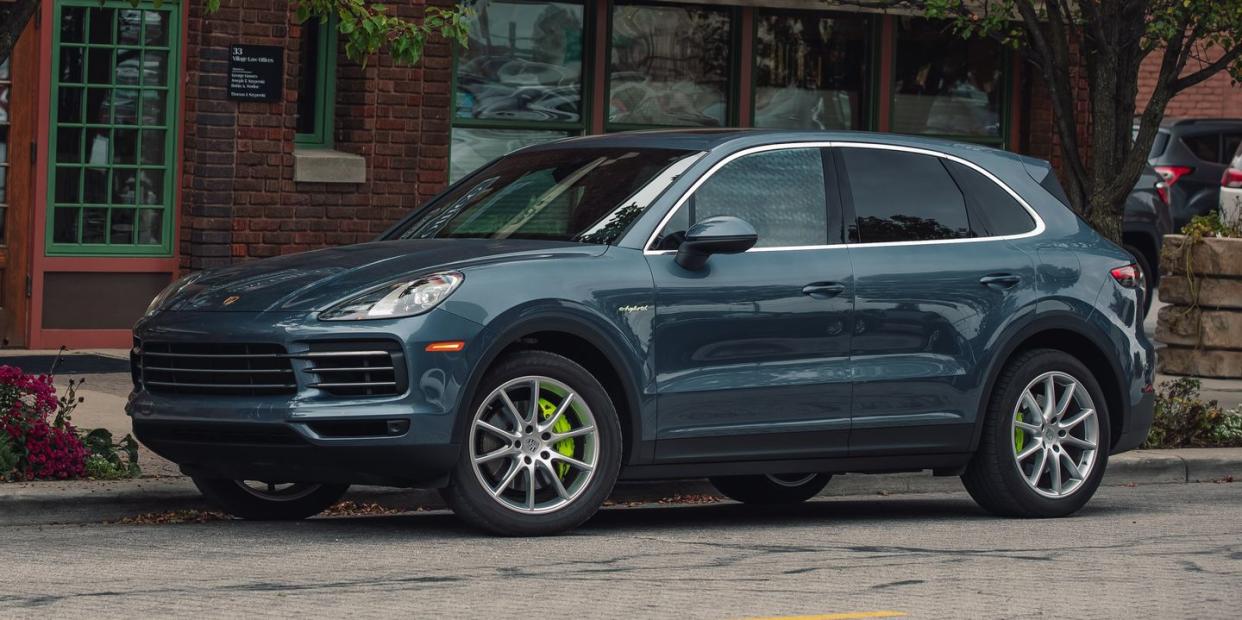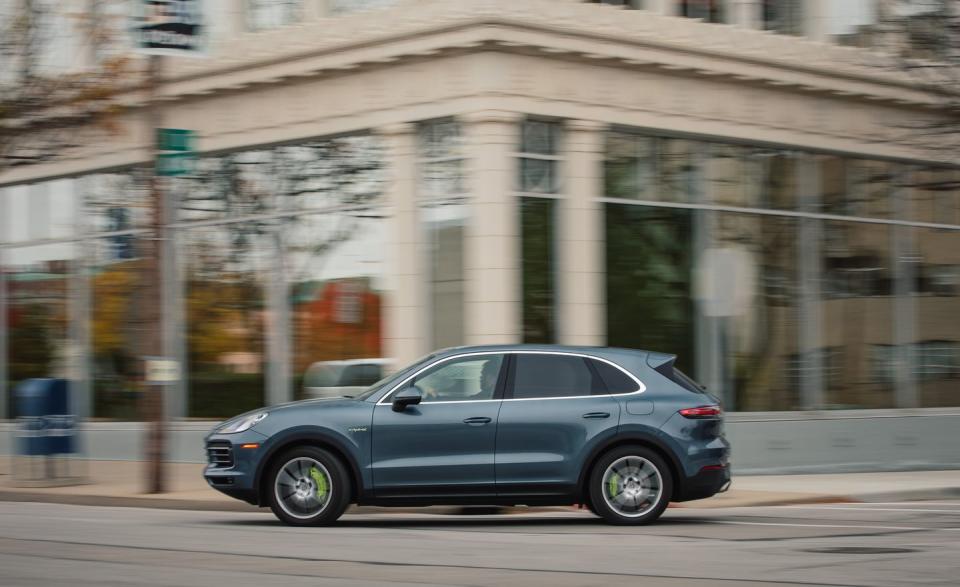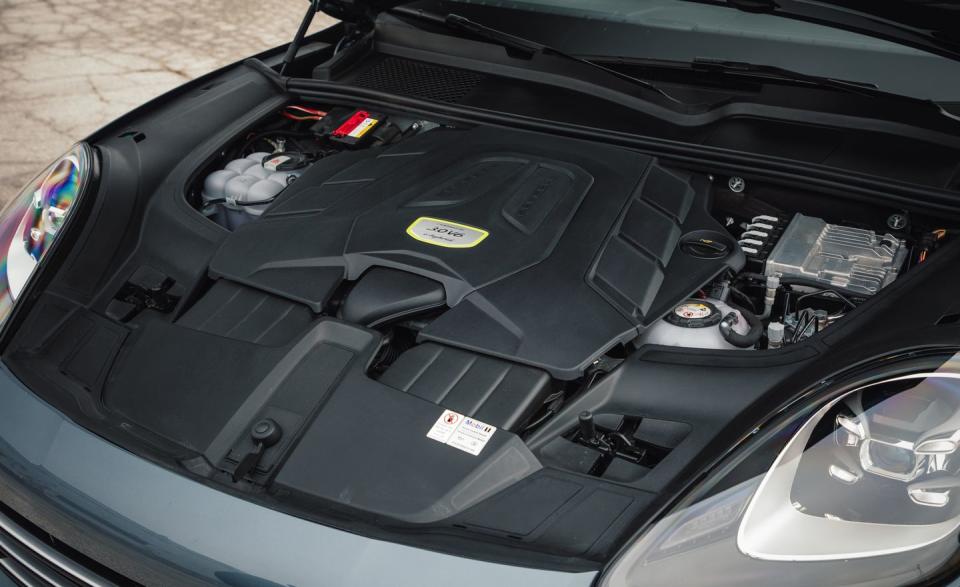Tested: 2019 Porsche Cayenne E-Hybrid Marries Performance and Efficiency

As a luxury SUV, the Porsche Cayenne E-Hybrid excels on multiple fronts. It's quick and gets decent fuel economy—when it's burning any fossil fuel at all. It handles well, yet it won't beat you up over poorly maintained pavement. It hints at environmental bona fides without shouting about it. And it still drives like a Porsche, albeit one that weighs 5389 pounds.
The latest Cayenne is one of many Volkswagen Group vehicles built off the manufacturer's highly flexible MLB Evo platform, which underpins everything from the Audi A4 to the Bentley Bentayga to the Lamborghini Urus. Building on our extensive first drive of the latest Cayenne E-Hybrid, back in 2018, this is the first time we've been able to strap our test gear to one.

For our particular plug-in E-Hybrid model, a relatively light load of options—highlighted by air springs and adaptive dampers, rear-wheel steering, a 7.2-kW onboard charger, and 20-inch wheels wrapped with Bridgestone Dueler H/P Sport summer tires (19s are standard)—upped its $81,150 base price to an as-tested $93,080. While that amount represents a substantial upcharge over the $68,150 entry point for the base Cayenne, the only other hybrid in the Porsche SUV stable is the 670-hp Cayenne Turbo S E-Hybrid, which starts at a stratospheric $163,250.
The E-Hybrid's 14.1-kWh lithium-ion battery is a modest pack of electrons good for 18 miles of electric-only range in our testing. Buyers with chargers on both ends of short commutes could go months without putting any premium unleaded in the conventional 19.8-gallon fuel tank. Compared to the E-Hybrid's EPA combined ratings of 46 MPGe and 22 mpg, our test car averaged just 22 MPGe while in the care of our heavy-footed group of drivers. Yet, with a full charge as it embarked on our 75-mph highway fuel-economy test that covers 200 miles, it returned an initial 49 MPGe that dropped to 25 mpg once the battery was depleted.

The E-Hybrid's battery adds a substantial amount of mass to its curb weight. While it's not as porky as the 5623-pound Turbo S E-Hybrid model that has a similarly sized pack, our 5389-pound example weighed 587 pounds more than the 434-hp Cayenne S model and 681 pounds more than the entry-level Cayenne.
In light of its considerable heft, the E-Hybrid's straight-line acceleration is more impressive than its fuel economy. With a combined output of 455 horsepower from a 335-hp turbocharged 3.0-liter V-6 and a 134-hp electric motor-generator sandwiched between the engine and standard ZF eight-speed automatic transmission, this is the most powerful Cayenne that doesn't wear a Turbo badge. There's a satisfying 516 pound-feet of torque on hand from 1000 to 3750 rpm, which helps it move off the line with strong low-end grunt. Engage the launch-control system in the Sport or Sport Plus drive modes, and this Porsche SUV shoots to 60 mph in a fleet 4.2 seconds—the same time as we've recorded for the Cayenne S and 0.7 second quicker than our long-term 2019 Cayenne managed when it was new. That figure also approaches the 3.9-second effort put up by the 523-hp BMW X5 M50i. Keep your foot in it, and the E-Hybrid will cover the quarter-mile in a solid 12.8 seconds at 108 mph.

If Porsches were solely about acceleration, the Cayenne E-Hybrid could stand on that talent alone. But all that mass does compromise its back-road frolic factor. The steering is excellent, and its overall balance at speed taps into your senses as if it were a far lighter vehicle. Yet there's simply no amount of chassis technology that can make the E-Hybrid feel as nimble around corners as its lighter siblings. Compared to the last Cayenne S we tested that rode on larger 21-inch Pirelli P Zero summer tires, our test car posted the same 0.93 g of grip around the skidpad but needed an additional 11 feet to stop from 70 mph, coming to halt in 166 feet.
Porsche's tuning for the Cayenne's regenerative braking takes some getting used to and does not allow for one-pedal driving that can bring the vehicle to a stop without touching the brake pedal. Toggling the Sport or Sport Plus driving modes brings sharper responses to its controls and a bit more athleticism to its character, although those settings can be rather aggressive around town and during mundane commutes.

Aside from its bright-green brake calipers and a few exterior badges, the E-Hybrid is easily mistaken for lesser Cayenne models. Inside, there are additional settings for the digital displays in its instrument cluster for monitoring the flow of energy throughout the hybrid powertrain. But its satisfying fit and finish and 12.3-inch center touchscreen are the same as in other Cayenne models, as is Porsche's latest high-tech center console layout that is largely shared with the more expensive Panamera.
While the Cayenne E-Hybrid does not drive quite as sharply as the lighter and slightly more expensive $85,650 Cayenne S model, it's about as quick and a touch more fuel efficient, especially when you factor in its useful all-electric capability. Depending on how you chose to deploy its energy, the E-Hybrid can fill several roles, from a near-silent suburban shuttle to a back-road companion. That its substantial weight penalty only somewhat hampers its precision and agility is a testament to the overall refinement of Porsche's latest Cayenne.
You Might Also Like

 Yahoo News
Yahoo News 
